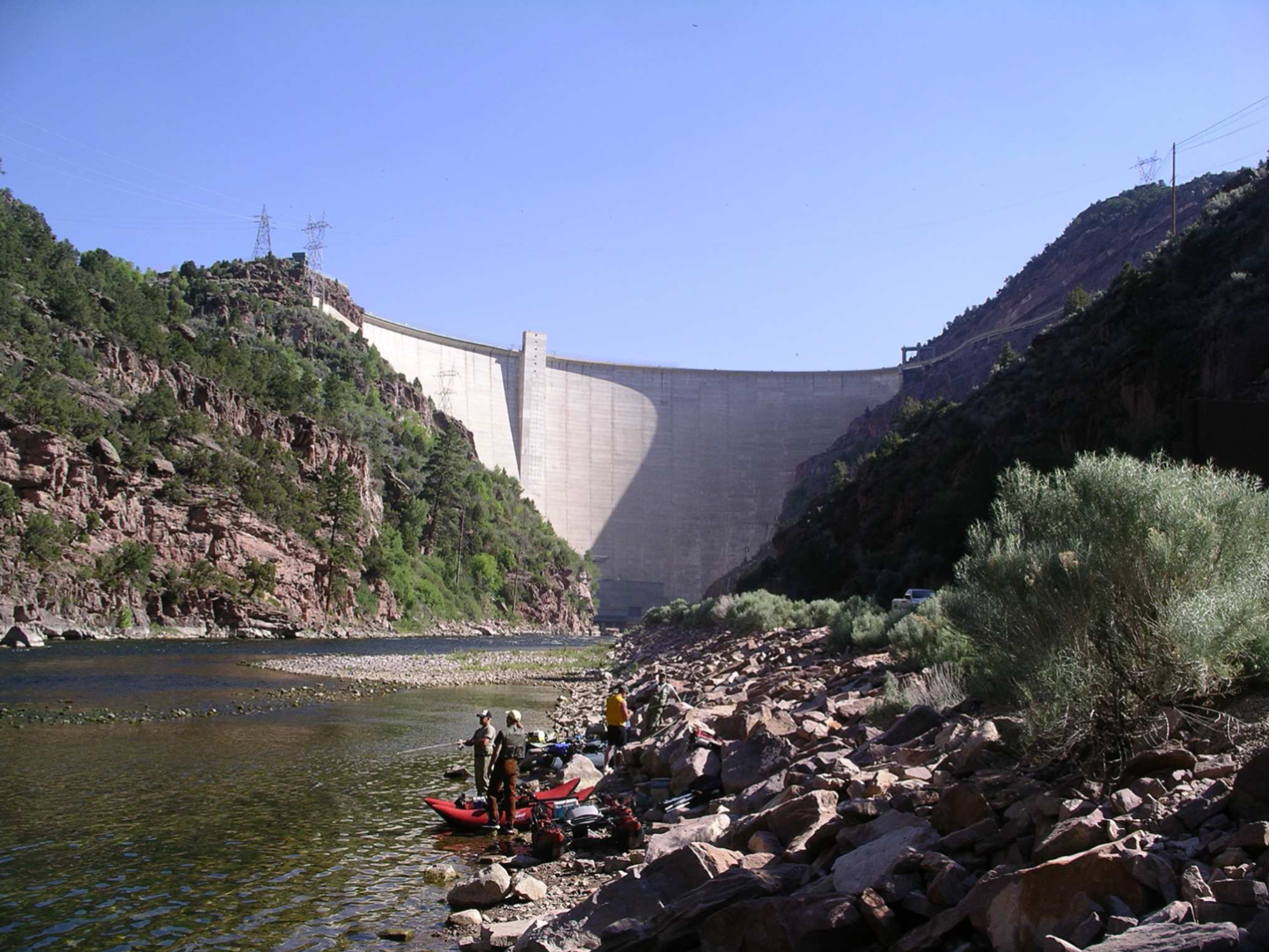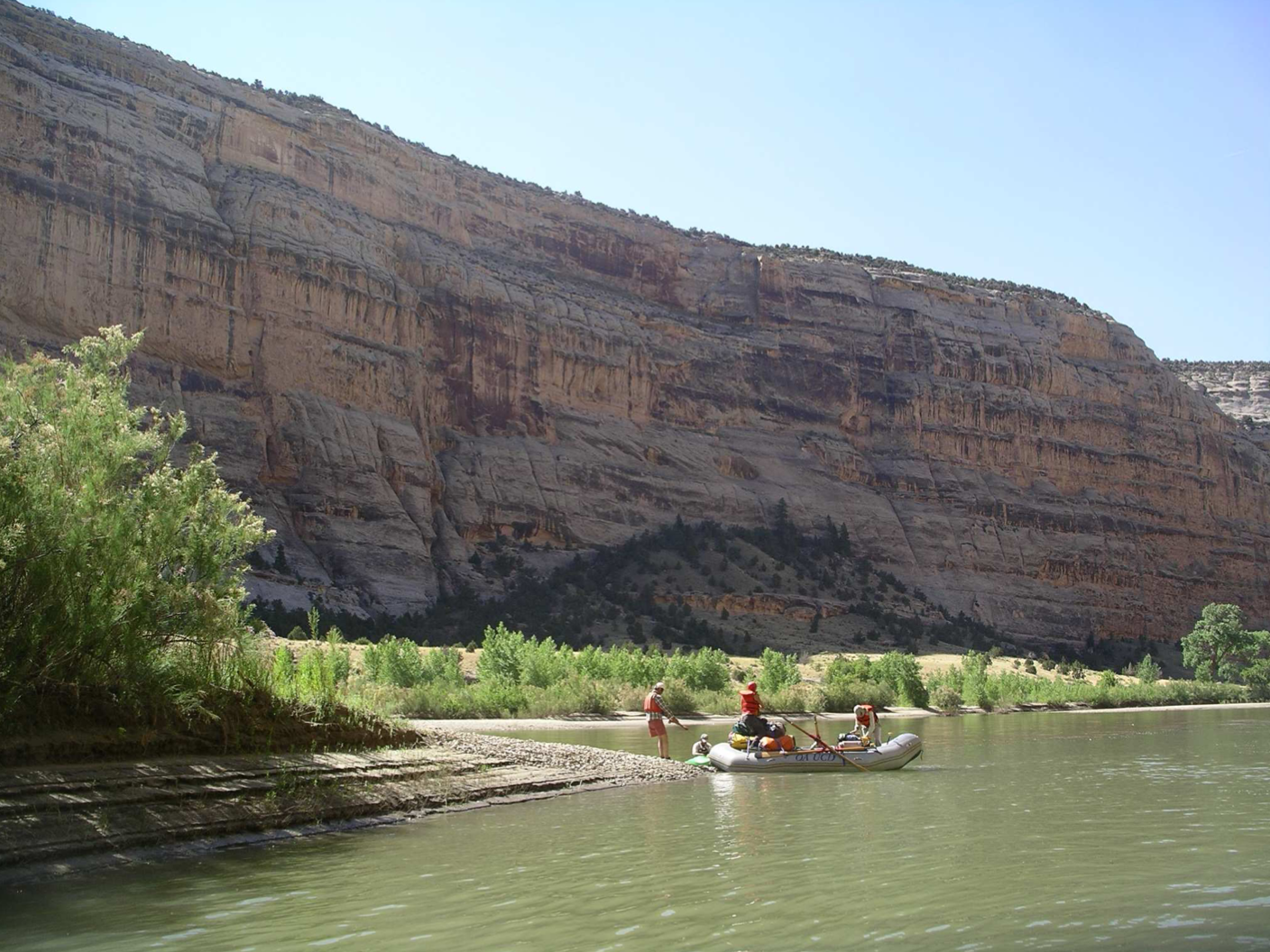The size of bed materials downstream of Flaming Gorge Dam changes depending upon the stream power and geology of specific reaches. In general, the bedload of the Green River above the confluence of the Yampa was mostly sand and silt while below the confluence, significantly more cobbles were transported. The Yampa, a large, unregulated tributary, greatly increases the flow and transport ability of the Green, especially during large floods.

Figure 1. Green River at Flaming Gorge Dam (Photo by Brooke Eustis)
Just below Flaming Gorge Dam (see Figure 1), the bed material is mostly boulder-sized deposits. The source of these boulders is probably rockfalls, pre-dam alluvium, as well as construction of the dam and bypass channel through the quartzite walls of the Precambrian Uinta Mountain Group. These boulders are not being transported and have likely been in place since the completion of the dam. Fine sediments in this area have been washed out leaving the bed armored. About seven miles downstream, at Little Hole, the bed is composed of mostly silt and some sand, gravel and cobbles. Here, the river has enough power to transport cobbles during high flows but usually transports finer sands and silt.
In Red Canyon, debris fans bring boulders, cobbles, and gravels into the river. Since flows are not capable of transporting these large materials downstream, the river constricts and pools are formed upstream and downstream from the constriction. Reduced flows in these pools cause sand and silt to deposit on the riverbed. Vegetation covering the bed material makes it difficult to assess sediment sizes in some locations.
In Upper Browns Park, a restricted meander, the river meanders through soft alluvium sediments with infrequent debris fans from the restricting bedrock. No deposits larger than cobble-sized are observed. Gravel is deposited along cutbanks at meander bends, likely due to increased flow velocity along the outsides of these bends. The bed material is mostly sand along straight reaches.
Swallow Canyon has quartzite canyon walls and is classified as a fixed meander since the river has incised its path through the bedrock. We had difficulty assessing the bed material here as most of the riverbed was covered in thick mosses and grasses.
Lower Brown’s Park is another restricted meandering reach. The bed material is mostly sand eroded from banks. The river is wide and very shallow, with numerous sandbars forming in the slow-moving waters. This almost braided river channel has been aggrading sediments at its margins as a result of reduced peak flows able to transport the sediments from eroded banks.
Lodore Canyon is dominated by debris fans similar to Red Canyon. The channel is restricted in many places by boulders from the abundant debris fans. Cobble bars are also common in the canyon but they occur just downstream of debris flows and have not been transported since the completion of Flaming Gorge Dam. Sand is transported and deposited by post-dam flows and aeolian processes.

Figure 2. Confluence of Green (bottom) and Yampa (top) (Photo by Brooke Eustis)
After the confluence with the Yampa River (Figure 2), we noticed a significant change in bank deposits and bed material. At the confluence, a large island has formed between the multiple channels of the Yampa River. On the Green River side of the island, the bank as well as the riverbed is covered with silt-sized sediments. The bank on the Yampa River side of the island, however, is covered by cobble-sized clasts. The bedload material in the Yampa River at the confluence is also cobble-sized. Downstream of the confluence, we also noticed active cobble bars in mid-channel islands in Island Park. This difference in bed and bank material appears indicative of the difference in river stream power between the regulated Green and unregulated Yampa. The unregulated flows of the Yampa River are still able to carry large sediment while the regulated flows of the Green River cannot.
At each reach below Flaming Gorge Dam, observations did not provide evidence for the transportation of anything larger than gravel-sized clasts until the confluence of the Yampa River. Instead, the river transported mostly sand, silt and some gravel-sized sediments. Large boulders and cobbles have entered the river channel from rockfalls and debris flows in canyons but have not been transported by flows. Cobble bars just downstream of debris fans demonstrate the river’s inability to transport these debris fan deposits. Below the confluence of the Yampa River, active cobble bars along channel margins are common. The Yampa River’s unregulated flows increase the Green River’s ability to transport larger clast sizes downstream of its confluence.
